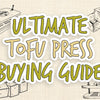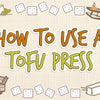How To Use A Tofu Press

You have just acquired a tofu press, and you cannot wait to enjoy all your favorite tofu recipes, but how do you press tofu using a tofu press? Worry not; learning how to use a tofu press is almost synonymous with a rite of passage ushering you into a world of a meatless diet and all its possibilities.
The good news is that once you get down to the brass tacks, how you use your tofu press will be dictated by the type of tofu you are working with and the firmness you are aiming for. This guide will take you through everything you need to know on how to press tofu using a press.
What Is a Tofu Press?

A tofu press is a simple kitchen tool that removes excess water from tofu to create a denser, firmer texture. It consists of two solid plates, often made from plastic or wood, that compress tofu between them and squeeze out moisture.
The bottom plate typically has a shallow reservoir or grooves to hold the block of tofu, while the top plate fits over it neatly. By tightening screws or clamps on the two sides of the press, the tofu is squeezed gently and incrementally without damaging the structural integrity of the tofu. The pressure applies enough force to the tofu to remove water that would otherwise make it soft and prone to crumbling.
The tofu becomes more compact, dense, and sliceable as the water accumulates in the reservoir or drips out the grooves. Tofu presses allow you to achieve tailored textures ranging from firm to extra firm, depending on pressing times. They are inexpensive, easy to use, and provide the most versatility from fresh tofu for optimum cooking results across many applications. After pressing, tofu can be marinated, cooked, baked, or incorporated into many delicious recipes.
Why Press Tofu?

Pressing removes excess water from the tofu.
Tofu is made from soy milk curds that contain a high moisture content. When cooked, the water makes raw tofu soft and prone to crumbling or falling apart. Pressing tofu manually squeezes out a significant amount of water in the soy curds. This makes the tofu much firmer and dense. Pressed tofu holds its shape better during cooking methods like frying, baking, and grilling. Unpressed tofu is more likely to break down into mush or liquid when exposed to heat.
Pressing condenses the proteins.
Raw tofu consists of suspended soy proteins and water. As pressing compacts the soy curds, these proteins move closer together within the tofu's internal structure. The proteins bond more tightly and reinforce the structural matrix. This condenses and firms up the curds, creating a meatier, chewier texture comparable to foods like chicken or steak. Unpressed tofu has a softer, looser protein network.
Pressed tofu absorbs flavors better.
The proteins and reduced water content in pressed tofu provide many sites for permeating and adhering to sauces, marinades, and seasonings. The marinade fills the gaps left behind as the water is expelled during pressing. Unpressed tofu already saturated with moisture limits how much extra flavor can penetrate the curds.
Better browning and crisping
When sauteed or baked, pressed tofu achieves nicer caramelization because less water evaporates before the proteins and sugars can brown. The Maillard reaction occurs more readily, creating crispier crusts. In unpressed tofu, escaping steam from the interior moisture often prevents crisping or browning.
More versatile cooking applications
Pressed tofu's firmer and denser nature allows it to withstand grilling, breading, simmering in stews, crumbling as a ricotta substitute, etc. Unpressed tofu can fall apart too easily under higher heat or mechanical stress. Pressing vastly improves the utility of tofu across recipes that call for different textures.
How to Use a Tofu Press

There are two main types of tofu presses; box presses and plate presses. While they all utilize the same principles of applying pressure onto a block of tofu to squeeze out the water, there are some variations in terms of setup, depending on the design. To get a clear picture of how to use a tofu press, we will cover both types of presses and how you can use them.
How to use a plate press

You will need a tofu press consisting of two solid plates, which are often made of wood, such as bamboo or solid plastic. Depending on the design, the bottom plate can have a shallow well or gloves that hold the tofu in place while the top plate fits neatly over the bottom plate.
Plate presses often include clamps or screws on the opposite sides that are used to tighten down the upper plate, applying pressure to the tofu. It's important to note that while you are better off buying a plate press, you can also use flat plates or two cutting boards to make a temporary tofu press, although the results might not be as consistent.
Follow the following steps to use a tofu plate press:
1. Prepare the tofuBefore you can start pressing the tofu, you will need to take it from the package and drain off any excess water. Depending on the size of your tofu press, you might need to cut the tofu block into one-inch thick slabs. In this case, cutting horizontally or diagonally works best.
If you are dealing with soft tofu, you can leave it in the full-block shape for pressing. When dealing with extra firm tofu, consider freezing the tofu block for upto two days before pressing. This expands the internal structure allowing more water to get pressed out after defrosting.
2. Set up the tofu press.Assemble the bottom and top plates of the tofu press, placing the tofu in the center of the bottom plate. Tighten the screws or clamps gradually and evenly on both sides to apply steady pressure. Remember to avoid over-tightening, which can damage the tofu or press plates. Tighten just until resistance is felt.
Let the tofu press for 20-30 minutes or up to 1 hour for very firm tofu. For extra firm tofu, open the press, flip the tofu, and repeat pressing on the second side. Once the tofu is pressed, carefully remove it from the press. You may need to use a knife to help you pry it out.
How to use a box tofu press

Box presses are more complex than plate presses but are more effective at removing moisture from tofu. Box presses consist of a box with a lid that has a lever that can be used to apply pressure to the tofu. The more pressure that is applied, the more moisture will be removed.
Follow the following steps to use a tofu box press:
1. Prepare the tofuMake sure your tofu is at room temperature before you start pressing. This will help the pressing process go more quickly. If your tofu is cold, you can let it sit at room temperature for about 30 minutes before pressing. You should also cut the tofu block into dimensions that fit snugly in the box press.
2. Set up the tofu press.Line the bottom of the tofu press with a piece of parchment paper or a clean kitchen towel. This will help prevent the tofu from sticking to the box press. Place the tofu halves in the tofu press with the cut sides facing down.
Tighten the press until the tofu is snug. You don't want to press it too hard, or you could damage the tofu. Place the tofu press on a countertop or table. Press the tofu for 30 minutes to 1 hour. The longer you press the tofu, the firmer it will become. Once the tofu is pressed, carefully remove it from the press. You may need to use a knife to help you pry it out.
Tips for using a tofu press

- After pressing the tofu, you can gently pat the block with paper towels to absorb residual moisture on the surface.
- Pressed tofu should be used right away. If you need to store the tofu, you will need to immerse it in fresh water and store it in the refrigerator for up to five days, remembering to change the water daily.
- After pressing tofu, disassemble the press parts and wash thoroughly with hot soapy water after each use to avoid cross-contamination. Remember to rinse and dry the parts thoroughly; leaving them wet can lead to odor retention.
- Consider freezing, thawing, and pressing a second time for ultra-firm tofu. The cellular structure breaks down further upon the second pressing.
- Not all tofu is created equal. For best results, use extra firm or super firm tofu. These types of tofu have a higher water content, which means they will absorb more marinade and flavors when you cook them.
- Line the bottom of the tofu press with a piece of parchment paper or a clean kitchen towel. This will help prevent the tofu from sticking to the press.
- The amount of time you need to press your tofu will depend on how firm you want it to be. Press it for 30 minutes to 1 hour for basic firm tofu. For a really firm tofu, you can press it for up to 2 hours.
Frequently Asked Questions (FAQs)

Why is the tofu still wet after pressing?
After pressing the tofu, you may still find its surface wet from the contact with the press. You can pat it dry with a paper towel to remove excess moisture while making cooking easier.
What if my tofu falls apart after pressing?
If your tofu is falling apart after pressing, it may be because you pressed it too hard. Try pressing it more gently next time.
Can I press flavored/baked tofu?
Only press plain raw tofu. Pressing cooked or baked tofu can damage the structure.
How long should you press tofu in a tofu press?
How long you should press tofu will be determined by the type of tofu and the results you are looking for. Typically medium firm tofu should be pressed for at least ten to thirty minutes, while firm and extra-firm tofu should be pressed for at least 1 hour. Do not press silken and soft tofu; it will just get squished because it is not sturdy enough to withstand the pressure.
Conclusion

Pressing tofu can easily overwhelm or confuse first-timers, but with this guide, you will find that the pressing process is relatively easy once you know what to do. Draining tofu allows it to hold its shape during the cooking process while also boring more marinades. The results are often worth the wait, especially in terms of how much flavors pressed tofu can absorb. If you are looking for an easy-to-use tofu press, you should consider getting a bamboo tofu press, as it's much easier to use and maintain.
Written December 2023
By Susan Grey







Hi, using the tofu press for the first time. What all needs mineral oil after cleaning? Thanks!